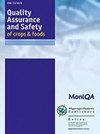Optimizing modified rice bran for treating aqueous solutions polluted by Cr (VI) ions: isotherm and kinetics analyses
IF 5.3
3区 农林科学
Q1 FOOD SCIENCE & TECHNOLOGY
引用次数: 14
Abstract
This study investigated the possibility and efficiency of absorbing chromium (VI) (Cr [VI]) ions from the polluted solutions by employing the chemically modified adsorbents (alkali, biochar, and acid rice bran), focusing on the possible impacts of the solution’s pH values, adsorbent’s dosages, concentrations, and contact times. The colori-metric method was used for Cr determination by employing an ultraviolet/visible spectrophotometer. The scanning electron microscope and Fourier transform infrared spectroscopy were used to analyze the characteristics of the modified adsorbents. The findings indicated that the optimized acid, biochar, alkali, and unmodified rice bran removal efficiency for Cr (VI) were 94.50%, 94.27%, 88.60%, and 90.18%, respectively. The increase of adsorbent dosage up to 2 g/L led to a rise in removal effectiveness (82.06%). Furthermore, the highest removal efficiency was obtained (94%) at the pH of 2.0, the contact duration of 100 min, Cr (VI) concentration of 50 mg/L, and dosage of 2 g/L, which was statistically the optimal condition for the modified rice bran. The adsorption kinetics was agreeably suited to pseudo-second-order, whereas the Freundlich isotherm equation was also suitably expounded the study’s findings. The findings implied that the acid and biochar rice bran performed remarkably in the reme-diation of the wastewater compared with alkali rice bran for reuse for industrial, agricultural, and environmental purposes.改性米糠处理Cr (VI)离子污染水溶液的优化:等温线和动力学分析
本研究考察了化学改性吸附剂(碱、生物炭和酸性米糠)从污染溶液中吸收铬(VI) (Cr [VI])离子的可能性和效率,重点研究了溶液的pH值、吸附剂的用量、浓度和接触时间对铬(VI)离子的可能影响。采用比色法,采用紫外/可见分光光度计测定铬。利用扫描电镜和傅里叶变换红外光谱分析了改性吸附剂的特性。结果表明,优化后的酸、生物炭、碱和未改性米糠对Cr (VI)的去除率分别为94.50%、94.27%、88.60%和90.18%。吸附剂投加量增加至2 g/L时,去除率提高82.06%。在pH为2.0、接触时间为100 min、Cr (VI)浓度为50 mg/L、投加量为2 g/L的条件下,去除率最高(94%),为改性米糠的最佳条件。吸附动力学符合拟二阶方程,Freundlich等温线方程也能很好地解释研究结果。研究结果表明,与碱米糠相比,酸米糠和生物炭米糠对废水的修复效果更好,可用于工业、农业和环境再利用。
本文章由计算机程序翻译,如有差异,请以英文原文为准。
求助全文
约1分钟内获得全文
求助全文
来源期刊

Quality Assurance and Safety of Crops & Foods
FOOD SCIENCE & TECHNOLOGY-
CiteScore
4.60
自引率
7.50%
发文量
61
审稿时长
1 months
期刊介绍:
''Quality Assurance and Safety of Crops & Foods'' is an international peer-reviewed journal publishing research and review papers associated with the quality and safety of food and food sources including cereals, grains, oilseeds, fruits, root crops and animal sources. It targets both primary materials and their conversion to human foods. There is a strong focus on the development and application of new analytical tools and their potential for quality assessment, assurance, control and safety. The scope includes issues of risk assessment, traceability, authenticity, food security and socio-economic impacts. Manuscripts presenting novel data and information that are likely to significantly contribute to scientific knowledge in areas of food quality and safety will be considered.
''Quality Assurance and Safety of Crops & Foods'' provides a forum for all those working in the specialist field of food quality and safety to report on the progress and outcomes of their research.
 求助内容:
求助内容: 应助结果提醒方式:
应助结果提醒方式:


